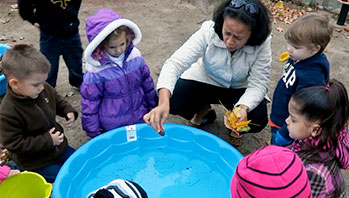- camera
- crayons
- garden hose
- paintbrushes
- paints
- paper
- bend
- color
- disappear
- light
- light, (n)
- prism
- rainbow
MA Draft STE Standards:
Physical Sciences/PS4.D: Compare and sort materials into those that allow all, some, or no light to pass through them. [Cause and Effect]
Head Start Outcomes:
Logic and Reasoning/Reasoning and Problem Solving: Recognizes cause and effect relationships.
Science Knowledge/Scientific Skills and Method: Uses senses and tools, including technology, to gather information, investigate materials, and observe processes and relationships.
Science Knowledge/Scientific Skills and Method: Collects, describes, and records information through discussions, drawings, maps, and charts.
Science Knowledge/Scientific Skills and Method: Describes and discusses predictions, explanations, and generalizations based on past experience.
PreK Learning Guidelines:
Science and Technology/Inquiry Skills 4: Record observations and share ideas through simple forms of representation such as drawings.
English Language Arts/Language 2: Participate actively in discussions, listen to the ideas of others, and ask and answer relevant questions.
Explore Together (outdoors): Make Rainbows

© Commonwealth of Massachusetts, Department of Early Education and Care. All rights reserved.
STEM Key Concepts: There are many different colors
ELA Focus Skills: Compare and Contrast, Speaking and Listening, Vocabulary
Choose a sunny day to take children outside to make and observe rainbows using water mist. Gather children in front of the materials outside and ask, How do you think we can make a rainbow using this hose and the water that comes out of it? Give children time to think about and discuss their ideas.
Have children face away from the sun. Then turn the nozzle of a garden nozzle to create a fine mist. Watch the rainbow form as sunlight hits the curve of falling water droplets.
- Ask, Do you remember what happened when we placed a prism in the sunlight? After children respond, say, These water drops act the same way the prism does when the light hits them. The water drops bend the light into colors.
- Turn off the water. Ask, What happened to the rainbow? Why did it go away, or disappear? Ask, Do you think the rainbow will return if I turn the water back on? Talk about how the rainbow appears when the water drops are hit by the sunlight. Let children take turns holding the hose and making the rainbow appear and disappear.
Once inside, have children draw a picture of their outdoor rainbow. Say, What colors will you need to draw a rainbow? Encourage them to include the sunlight and mist that created the rainbow.
Reflect and Share
Have children share what they observed in their explorations. Have their drawings available so children can point to and clarify their ideas. Ask children to compare this experience with making rainbows indoors. Ask, What was the same about making rainbows indoors and outdoors? What was different? Were all the colors of the rainbows we made the same? Why or why not?
Adaptation: If you have older children in your group, you may wish to do another rainbow exploration. On a sunny day, place a clear mixing bowl that is a little over half full of water on a windowsill facing the sun. Stand a flat mirror against one side of the bowl at an angle in the water. Point the mirror toward the sun. Keep moving the mirror until it catches the light and creates a rainbow. Discuss how the clear, transparent water breaks the sunlight into its colors and the mirror reflects the colors as a rainbow.
